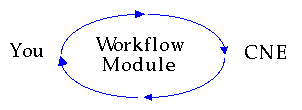
In the early 1900's, Frederick Taylor articulated the principle of "scientific management", a view that sees work as motions and activities of workers that can be planned and optimized by managers. With the introduction of the electronic computer 50 years ago, it became possible to draw a parallel between the motions and activities of workers and the flows and transformations of information; accordingly, the individual worker could be modeled as a function that processes input information into output information.
Another interpretation of work was offered in the 1950s when Herbert Simon described management as decision-making by evaluating alternatives. Information technology was then viewed as providing information to the worker to make better decisions. In the 1960s Jay Forrester analyzed organizations as nonlinear feedback signal-processing systems. Today, these information interpretations of work have been embodied in systems such as Forester's Systems Dynamics and IDEF0, a dataflow analysis method originally designed for observing commodity flows in manufacturing plants. In all these systems, work is seen as the process of transforming the given inputs into the desired outputs.
Back to Organizational Processes

MRH
9/14/94